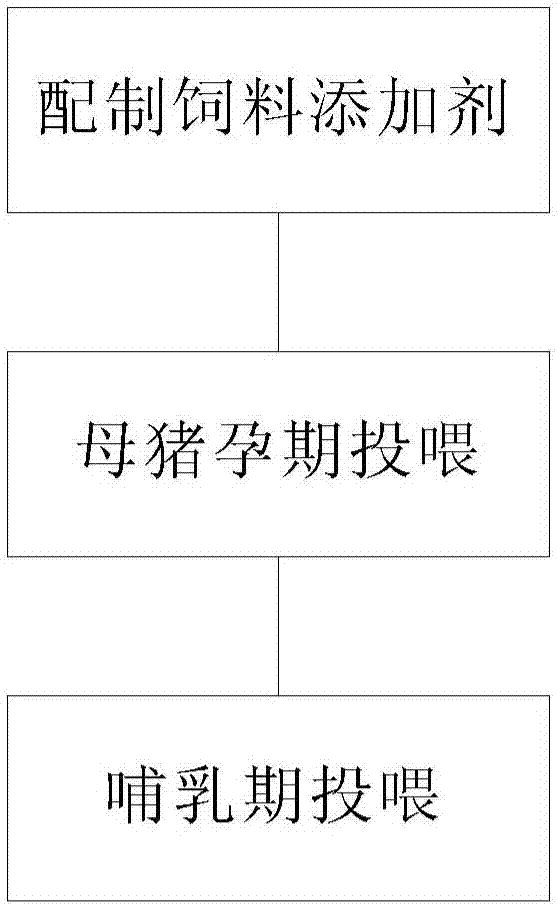Chinese herbal medicine feed additive for dams and breeding method applying same
A technology of feed additives and breeding methods, which is applied in the field of Chinese herbal medicine feed additives for female animals, can solve the problems of troublesome procurement of Chinese herbal medicine raw materials and quality control, and unstable effects, so as to reduce the weaning and transfer diseases of piglets, improve their own resistance, and improve the quality of female animals. The effect of resistance
- Summary
- Abstract
- Description
- Claims
- Application Information
AI Technical Summary
Problems solved by technology
Method used
Image
Examples
Embodiment 1
[0038] The sows were reared according to conventional methods, and ordinary sow feed was used. details as follows:
[0039] Pre-pregnancy: digestible energy is 2.8 Mcal / kg, crude protein 11%. The formula is: 32% corn, 30% wheat bran, 7% rice bran, 5% soybean meal, 12% sorghum, 2% bone meal, 10% barley, 0.5% iodized salt, and 1% compound additive.
[0040] Late pregnancy: digestible energy is 2.8 Mcal / kg, and crude protein is 12%. The formula is: rice bran 14%, wheat bran 24%, corn 31%, fish meal 2%, broken rice 18%, soybean meal 8%, iodized salt 0.4%, bone meal 1.6%, compound additive 1%.
[0041] The gestation period of pigs is 114 days. At about 104 days, the sows are driven out from the gestation pig house, cleaned and disinfected and sent to the delivery room. The delivery room should be kept quiet, clean and hygienic, which is conducive to stabilizing the emotions of sows and smooth production.
Embodiment 2
[0043] By weight, take 10 parts of Ligustrum lucidum; 10 parts of Folium Artemisiae Argyi; 8 parts of Dendrobium; 5 parts of Eucommia ulmoides; 10 parts of Radix Glycyrrhiza; 250 parts of protein powder.
[0044] The raw materials of each component are mixed according to the weight ratio of the components and then made into powder. The particle size of the powder is 0.2mm, which is more palatable to female animals and does not affect the feed intake. This feed additive is added in common sow feed, and addition is 1% of feed total amount, mixes homogeneously. In daily feeding, postpartum sows were fed with the above-mentioned feed added with feed additives; 50 Du Chang Sanyuan non-hybrid sows were selected, and the test period was 6 months. The sows were kept in the same house and dewormed half a month before mating. The mating was natural mating with the same boar twice within 24 hours or artificial insemination with the semen of the same boar. , After mating, the individual...
Embodiment 3
[0046] By weight, 20 parts of Ligustrum lucidum; 15 parts of Artemisia argyi; 20 parts of Dendrobium; 15 parts of Eucommia ulmoides; 20 parts of licorice; 750 parts of protein powder.
[0047] The raw materials of each component are mixed according to the weight ratio of the components and then made into powder. The particle size of the powder is 0.2mm, which is more palatable to female animals and does not affect the feed intake. This feed additive is added in common sow feed, and addition is 1.5% of feed total amount, mixes homogeneously. In daily feeding, postpartum sows were fed with the above-mentioned feed added with feed additives, and 50 non-hybrid sows of Du and Sanyuan were selected for a test period of 6 months. The feeding and management method of sows is the same as in Example 1.
PUM
| Property | Measurement | Unit |
|---|---|---|
| Particle size | aaaaa | aaaaa |
| Particle size | aaaaa | aaaaa |
Abstract
Description
Claims
Application Information
 Login to View More
Login to View More - R&D
- Intellectual Property
- Life Sciences
- Materials
- Tech Scout
- Unparalleled Data Quality
- Higher Quality Content
- 60% Fewer Hallucinations
Browse by: Latest US Patents, China's latest patents, Technical Efficacy Thesaurus, Application Domain, Technology Topic, Popular Technical Reports.
© 2025 PatSnap. All rights reserved.Legal|Privacy policy|Modern Slavery Act Transparency Statement|Sitemap|About US| Contact US: help@patsnap.com



